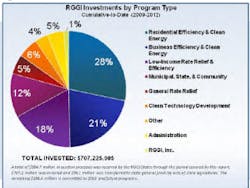The Northeast and Mid-Atlantic states win top spots again and again for energy efficiency. Massachusetts has been number one three years running in an annual scorecard by the American Council for an Energy-Efficient Economy. And five of its neighbors were in the top 10 last year.
Is there a secret sauce?
One thing they all have in common is that they participate in a mandatory carbon dioxide cap and trade program, the Regional Greenhouse Gas Initiative.
RGGI is a complex program that boils down to the simple idea that if you reduce power use then you reduce carbon dioxide emissions. In essence, it works like this. 1) Cap the amount of carbon that power plants can emit. 2) Let them meet the restriction by buying carbon allowances at auction 3) Use a big chunk of the money from the auction for energy efficiency. 4) Then the state uses less power, burns less fossil fuel, and emits less carbon dioxide.
So is it working?
It seems so based on a recent analysis RGGI published about its program from 2009-2012
The states have channeled about $700 million of RGGI money into various programs, about 63 percent for energy efficiency.
Source: “Regional Investment of RGGI CO2 Allowance Proceeds, 2012”, February 2014
RGGI reported these results:
- $1.8 billion in energy savings over the lifetime of measures
- 8 million MWh of electricity saved
- 37 million MMBTU of fossil fuels saved
- 7.1 million short tons of carbon dioxide emissions avoided
To be fair, RGGI is only one source of energy efficiency funding in the Northeast and Mid-Atlantic. Money also comes from utility charges to ratepayers, the ISO England forward capacity market, federal funds, and other sources. Massachusetts, alone, expects to accrue $1.6 billion in funds from various places for its 2013-2015 energy efficiency plan, with RGGI contributing about $90.9 million.
So RGGI’s not the secret sauce entirely, but it’s an important ingredient, one that’s helping to keep the Northeast and Mid-Atlantic in the top tier nationally for energy efficiency. If discussion of federal cap and trade gets serious again – a big if – these RGGI numbers deserve a look.
The RGGI report, with state by state funding information, is available here.
Could the RGGI model work nationally to reduce energy use? What do you think? Please post your thoughts on the Energy Efficiency Markets LinkedIn Group.







